ArtLab Explores Intersections of Art and Science at the Wond’ry
Whether art can actually boost a scientist’s creativity is just one of the intriguing questions that a group of faculty, students and staff are exploring in ArtLab, an interdisciplinary workshop started last fall by Kendra Oliver, an instructor of pharmacology.
“This has been a dream come true for me,” said Oliver, who describes herself as an “intensely trained scientist” and practicing artist. “I don’t have a background in the arts but have a longtime interest in concepts like data visualization. I anticipated that ArtLab would attract artists and scientists who were interested in working together, but was surprised to find that most participants identify as both,” she said.
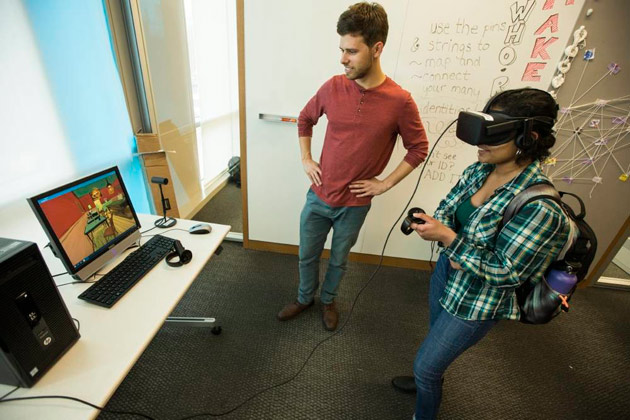 The goal of ArtLab, which is sponsored by the Curb Center for Art, Enterprise and Public Policy and the Wond’ry, is to explore the boundaries of art and science through seminars and project-based exploration. The workshop also receives strong support from the Communication of Science and Technology Program within the College of Arts and Science.
The goal of ArtLab, which is sponsored by the Curb Center for Art, Enterprise and Public Policy and the Wond’ry, is to explore the boundaries of art and science through seminars and project-based exploration. The workshop also receives strong support from the Communication of Science and Technology Program within the College of Arts and Science.
“The Curb Center hopes to expand ArtLab next year, increasing its interdisciplinary focus and embedding artists in some science research projects,” said Elizabeth Meadows, assistant director. Funding from the Curb’s Catalyst Creativity Grant Program will help make that possible.
Among many research areas represented in ArtLab are pharmacology, biological sciences, biochemistry, physics and astronomy, engineering and psychology.
An ArtLab pop-up exhibition— with more than 50 artists and scientists contributing original works within the art and science intersection—was on display at the Wond’ry March 1-2. Among the exhibitors was David Sweatt, professor and chair of the Department of Pharmacology, whose paintings focus on biostatistics in various fields, such as behavioral assays.
“Professor Sweatt was the first faculty member with whom I discussed the idea of ArtLab, and he has been a wonderful mentor,” said Oliver, who is transitioning from research fellow in the Division of Nephrology and Hypertension to instructor in pharmacology this month. She has worked closely on ArtLab programming with undergraduate Eve Moll, who has a strong interest in art even though she considers herself a science person.
“ArtLab helped me realize these two things aren’t mutually exclusive,” Moll said. “I plan to study molecular and cellular biology at Vanderbilt, then attend medical school. I am very passionate about academics, particularly science. I will never stop painting, though. It will always be a passion of mine too. The chance to experience these two passions coming together has been such a treat for me and many other participants in ArtLab.”
Moll, Oliver and Marilyn Murphy, professor of art, emerita, are collaborating to explore the representation of “Women in Science.” Items on display at the Wond’ry include a portrait of four women scientists who were Nobel Prize winners, with blue and red dots as the background. The blue and red dots are based on the demographic data detailing male and female Nobel Prize winners in science. The blue (male) dots outnumber the red (female) dots.
Programming connected to the ArtLab exhibition included a collective discussion with visiting lecturer Daniel Kohn, along with presentations by Vesna Pavlović, associate professor of art; Miriam Lense, research instructor, Vanderbilt Music Cognition Lab; and Sweatt. Jay Clayton, director of the Curb Center and the William R. Kenan Professor of English, spoke earlier this semester on the history of art/science collaborations at Vanderbilt.
“For me, bridging art and science is a way to open the beauty and complexity of science to diverse learners of all ages and backgrounds,” Oliver said.—Research News@Vanderbilt (April 2, 2018)
*A virtual reality environment where sophomore Chirayil, a makerspace ambassador, watches a Van Gogh painting (“Night Cafe”) come to life in 3D. To the left is senior Miguel Moravec, an augmented reality and virtual reality ambassador at the Wond’ry. (Photograph courtesy of Steve Green/Vanderbilt)
Posted by vrcvanderbilt on April 27, 2018 in Digital Humanities, HART, News, Student/Alumni, Technology, VRC
Kevin Murphy to Deliver Keynote at 1st International Ephemera Studies Symposium April 25-27
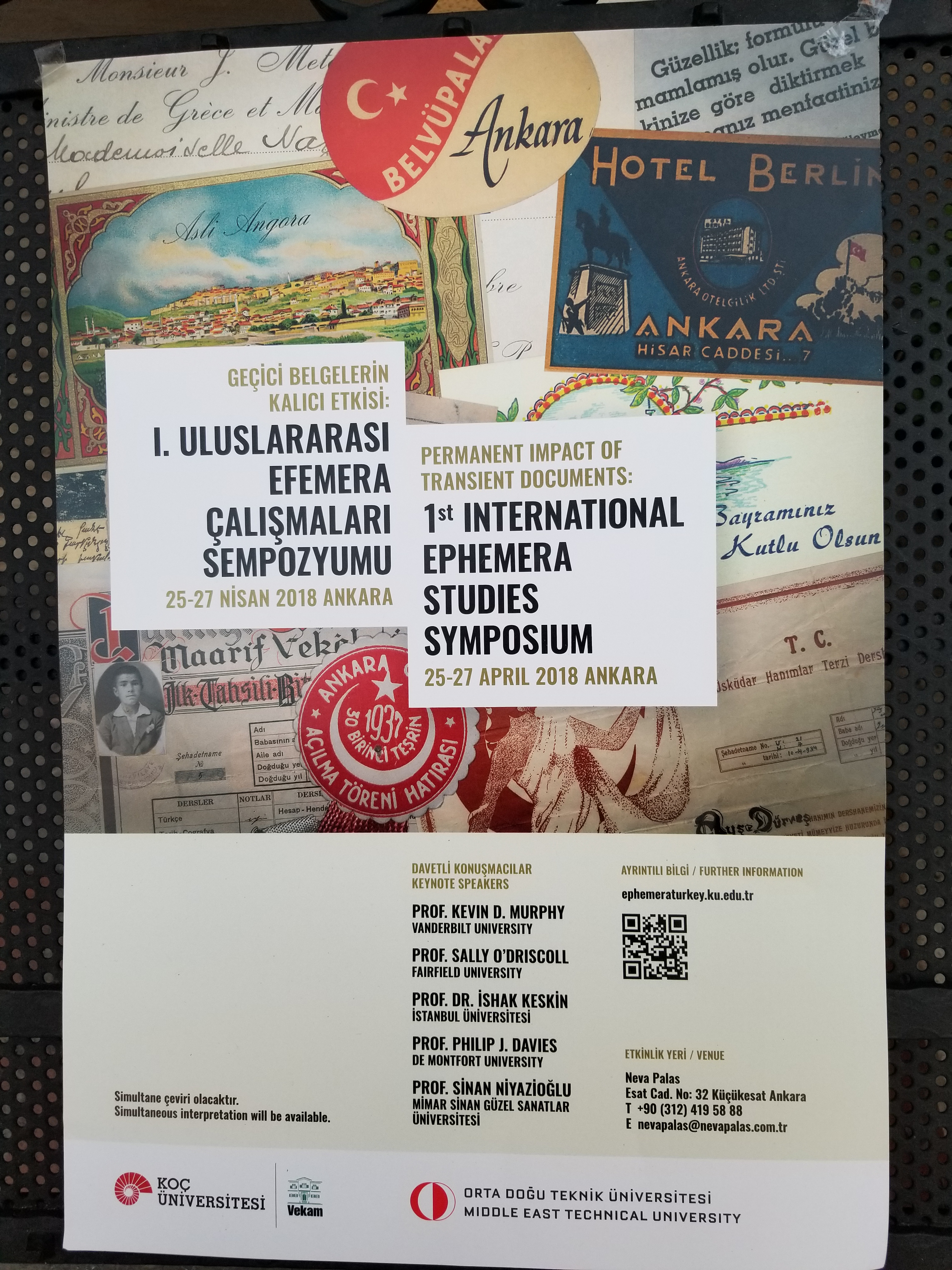 Kevin Murphy, chair and professor of history of art, will co-present with Sally O’Driscoll, professor of English, Fairfield University, the keynote address at a conference entitled “Permanent Impact of Transient Documents: 1st International Ephemera Studies Symposium,” held April 25-27 at Koç University, Ankara, Turkey. Murphy and O’Driscoll will examine “The Invisible Touch of Ephemera: How the Past Shapes the Present.”
Kevin Murphy, chair and professor of history of art, will co-present with Sally O’Driscoll, professor of English, Fairfield University, the keynote address at a conference entitled “Permanent Impact of Transient Documents: 1st International Ephemera Studies Symposium,” held April 25-27 at Koç University, Ankara, Turkey. Murphy and O’Driscoll will examine “The Invisible Touch of Ephemera: How the Past Shapes the Present.”
“Ephemera”—the plural form of “ephemeron”—is derived from the Greek word ephemeros meaning “lasting only one day.” Maurice Rickards, as an outcome of the ephemeral materials he gathered for his collection and his research throughout the 20th century, paved the way for the recognition of ephemera studies as an emergent academic discipline. He defined “ephemera” as “the minor transient documents of everyday life.”
Such printed documents as newspapers and magazines, cinema tickets, theater programs, leaflets, broadsides, posters, music sheets, chocolate cards, fez labels, calendars, business cards, match boxes, postcards, restaurant menus and even seed packets are all assessed within the scope of the transiency of printed ephemera. Despite the fact that this impermanence may have predicted the ultimate outcome of ephemera as “rubbish,” today these documents are all regarded as valuable, permanent and significant reference guides that are waiting to be discovered since they reveal the noteworthy economic, cultural, political, social and technological developments and changes of the time periods to which they belong.
Posted by vrcvanderbilt on April 26, 2018 in Conferences, Events, HART, Lectures, News, VRC
Recent Acquisition ~ “Alban Trilogy” by Giovanni Battista Piranesi
 The Jean and Alexander Heard Library has acquired the Alban Trilogy, a beautiful bound volume by Giovanni Battista Piranesi (1720-1778), containing three monographs on ancient monuments in the Alban Hills near Rome: Descrizione e disegno dell’emissario del Lago Albano (Description and Design of the Emissarium of Lake Albano), 1762; Di due spelonche ornate dagli antichi alla riva del Lago Albano (On Two Caves Embellished by the Ancients on the Shore of Lake Albano), 1762; and Antichità d’Albano e di Castel Gandolfo (Antiquities of Albano and of Castel Gandolfo), 1764-69. Each is composed of copper-plate etchings and text pages.
The Jean and Alexander Heard Library has acquired the Alban Trilogy, a beautiful bound volume by Giovanni Battista Piranesi (1720-1778), containing three monographs on ancient monuments in the Alban Hills near Rome: Descrizione e disegno dell’emissario del Lago Albano (Description and Design of the Emissarium of Lake Albano), 1762; Di due spelonche ornate dagli antichi alla riva del Lago Albano (On Two Caves Embellished by the Ancients on the Shore of Lake Albano), 1762; and Antichità d’Albano e di Castel Gandolfo (Antiquities of Albano and of Castel Gandolfo), 1764-69. Each is composed of copper-plate etchings and text pages.
According to ancient legend, the area west of the Alban Lake was where Alba Longa was founded by Ascanius, son of Aeneas; it was perhaps most famous as the birthplace of Romulus and Remus. The crater lake’s sapphire waters and the well-wooded crater edge attracted elite Romans of the late Republic and Empire, and a number of splendid residences were built. The most famous is the villa of the emperor Domitian (r. 81-96 CE), now largely integrated into the gardens of the Apostolic Palace at Castel Gandolfo. When Carlo Rezzonico became Pope Clement XIII (p. 1758-69), he invited Piranesi to the papal residence to work as architect and antiquarian. Piranesi conducted careful studies of the monuments across the area, both on high ground between Castel Gandolfo and Albano Laziale and down by the lakeshore. There, two natural caves had been converted into elaborate reception/dining halls in antiquity, and a monumental intake-building marked the beginning of the emissarium, an 1800-m-long tunnel penetrating the crater’s edge to deliver water to the fields beyond. With rustic masonry walls and complex hydraulic engineering, this monument especially fascinated Piranesi. He published his efforts in the three monographs included in this acquisition.
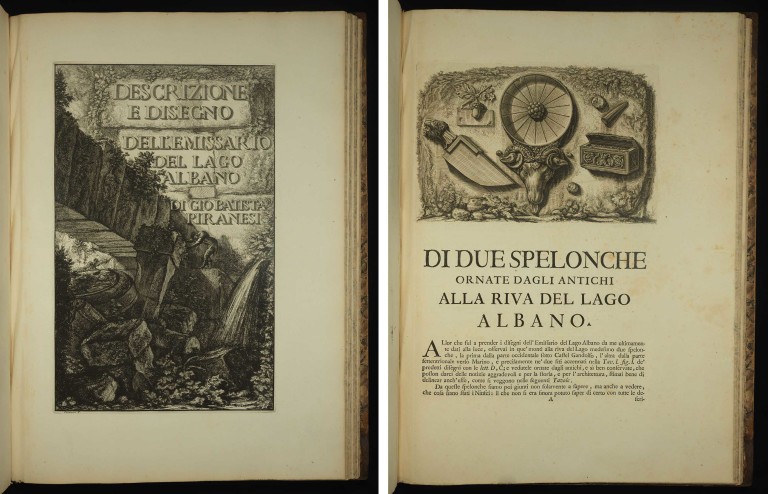 The etchings by Piranesi are beautiful and powerful, the work of a true master at the height of his career. The accompanying texts are important documents of Enlightenment scholarship. This acquisition will directly benefit faculty and student research and teaching in the subjects of History of Art and Classical and Mediterranean Studies, especially the history of prints and printmaking, comparative media studies, archaeology and its historiography, and history of science and engineering. This copy of the “trilogy” is the first to come to the American South, and it complements other works by Piranesi in the Vanderbilt University Fine Arts Gallery. It is available for consultation in Special Collections, Vanderbilt University Library and a special exhibition highlighting this acquisition is planned for Commencement week.
The etchings by Piranesi are beautiful and powerful, the work of a true master at the height of his career. The accompanying texts are important documents of Enlightenment scholarship. This acquisition will directly benefit faculty and student research and teaching in the subjects of History of Art and Classical and Mediterranean Studies, especially the history of prints and printmaking, comparative media studies, archaeology and its historiography, and history of science and engineering. This copy of the “trilogy” is the first to come to the American South, and it complements other works by Piranesi in the Vanderbilt University Fine Arts Gallery. It is available for consultation in Special Collections, Vanderbilt University Library and a special exhibition highlighting this acquisition is planned for Commencement week.
The Library Collections Initiative, a program funded by the chancellor and the provost, supports research and scholarship through investments in the permanent and special collections of Vanderbilt’s Jean and Alexander Heard Libraries. Faculty work with librarians to identify collections that enhance the depth and breadth of our research holdings. ~Betsey A. Robinson, associate professor of history of art
Images (above): Antichità d’Albano e di Castel Gandolfo (Antiquities of Albano and of Castel Gandolfo), 1764-69; (below): Descrizione e disegno dell’emissario del Lago Albano (Description and Design of the Emissarium of Lake Albano), 1762; and Di due spelonche ornate dagli antichi alla riva del Lago Albano (On Two Caves Embellished by the Ancients on the Shore of Lake Albano), 1762
Posted by vrcvanderbilt on April 25, 2018 in HART, News, Vanderbilt University, VRC
Kevin Murphy and Alumna Mary Anne Hunting Present Paper at Conference of Society of Architectural Historians
Kevin Murphy, department chair and professor of history of art, and Mary Anne Hunting, Vanderbilt alumna (BA’80) and independent scholar, jointly presented a paper at the annual international conference of the Society of Architectural Historians held April 18-22 in Saint Paul, MN. Their talk, “The Professional Couples in Histories of American Modernism,” was presented in the session entitled “Life to Architecture: Uncovering Women’s Narratives.”
Married architect couples have failed to attract scholarly treatment recognizing their individual contributions and evaluating the effectiveness of the partnership, especially for women. Their paper examines the professional partnerships of modernist architect couples from the interwar and postwar periods to demonstrate that while the model of collaboration was central to modernism, its results were mixed. Professional collaboration for women was often too socially and politically unfamiliar in the United States to lead to their widespread career success, nor could the work produced by a couple—as opposed to a singular (male) architect—be understood within modernist paradigms.
 Many of the modern “masters” had wives who supported the work of their husbands and fostered their legacies, but working partnerships of married women and men architects were less common. The partnership of Aino Marsio-Aalto and Alvar Aalto has been considered an anomaly in the modernist movement and has attracted recent scholarly attention. However, there were others just as significant, including Matthew and Stanislawa (Siasia) Sandecka Nowicki, whose collaboration critic Lewis Mumford described as “the closest of partnerships,” and the firm of Victorine and Samuel Homsey whose partnership produced well-published modernist as well as traditional buildings made all the more remarkable by their marriage and family.
Many of the modern “masters” had wives who supported the work of their husbands and fostered their legacies, but working partnerships of married women and men architects were less common. The partnership of Aino Marsio-Aalto and Alvar Aalto has been considered an anomaly in the modernist movement and has attracted recent scholarly attention. However, there were others just as significant, including Matthew and Stanislawa (Siasia) Sandecka Nowicki, whose collaboration critic Lewis Mumford described as “the closest of partnerships,” and the firm of Victorine and Samuel Homsey whose partnership produced well-published modernist as well as traditional buildings made all the more remarkable by their marriage and family.
Victorine Homsey was a graduate of the all-women Cambridge School of Architecture and Landscape Architecture, which produced many graduates who worked collaboratively with spouses. The Architects Collaborative was composed of Walter Gropius and seven other architects, including two married couples, Norman and Jean Fletcher and John and Sarah Harkness, who lived close to one another to facilitate their support of each others’ professional and family responsibilities. Such personal innovations often produced formal experimentation as Murphy and Hunting demonstrate through an examination of several key works produced by each of the couples whose partnerships we will also evaluate.
Murphy and Hunting have previously worked together as scholars and architectural historians. Hunting received her doctorate from the City University of New York’s Graduate Center where Murphy was her advisor. Author of Edward Durell Stone: Modernism’s Populist Architect (W. W. Norton & Company, 2012), Hunting presented a lecture entitled “Edward Durell Stone, Modernist Architect: From Vanderbilt to Kennedy Center” as part of Vanderbilt’s Fall 2013 Homecoming events.
*Herbert Matter (1907-1984). Aino Marsio‐Aalto and Alvar Aalto in the Artek‐Pascoe showroom, New York, 1940. Photograph courtesy of Bard Graduate Center Gallery, New York.
Posted by vrcvanderbilt on April 25, 2018 in Conferences, Events, HART, Lectures, News, Student/Alumni, VRC
Free Coffee Available in Cohen 134 During Final Exams: April 24-May 3

As the spring semester comes to a close, the Visual Resources Center (VRC) invites students, faculty, and staff to join us for a free cup of coffee—or two or three—in Cohen 134. Coffee will be available throughout the day during the final exam period, beginning on “reading day,” Tuesday, April 24, through Thursday, May 3.
Pour yourself a cup and dash to class or stay for a while and review images streaming across the big screen at the end of our large study table or simply sit down and take some time to relax and enjoy a cup of java. The VRC is open weekdays from 8:00 a.m. to 6:00 p.m.
Posted by vrcvanderbilt on April 24, 2018 in Events, HART, VRC
Leonard Folgarait to Lead Gallery Tour of “Under the Mexican Sky” at Chattanooga’s Hunter Museum
 Leonard Folgarait, Distinguished Professor of History of Art, will give an in-gallery walking tour of “Under the Mexican Sky: A Revolution in Modern Photography,” a current exhibit at the Hunter Museum of American Art, Chattanooga, on April 19. Folgarait is a specialist in Latin American art with a focus on Mexican art and photography. He is also the author of Seeing Mexico Photographed: the Work of Horne, Casasola, Modotti, and Álvarez Bravo.
Leonard Folgarait, Distinguished Professor of History of Art, will give an in-gallery walking tour of “Under the Mexican Sky: A Revolution in Modern Photography,” a current exhibit at the Hunter Museum of American Art, Chattanooga, on April 19. Folgarait is a specialist in Latin American art with a focus on Mexican art and photography. He is also the author of Seeing Mexico Photographed: the Work of Horne, Casasola, Modotti, and Álvarez Bravo.
Mexico City in the 1920s-30s was the scene of one of the great artistic flowerings of the twentieth century. Like Paris in the aftermath of World War I, Mexico City after the Mexican Revolution (1910-1920) served as a magnet for international artists and photographers. These photographers were often commissioned by the Mexican government and helped create a modern vision for the country’s future. Through their exuberant melding of art, culture, and identity, photography blossomed into a modern art form.
On view through April 22, this exhibition explores the important role Mexico and Mexico City played in the development of international modernism through rare vintage photographs from the 1920s by Los Angelino Edward Weston and Hollywood silent film star-turned-photographer, Tina Modotti. It also includes stellar photographs from the 1930s by New Yorker Paul Strand, Frenchman Henri Cartier-Bresson, and Mexico’s Manuel Álvarez Bravo.
Folgarait’s gallery lecture and tour is part of the Art Wise: Distinguished Speakers at the Hunter series.
*Edward Weston (1886-1958), Rosa Covarrubias, 1926, vintage gelatin silver print, 9 x 6 3/4 inches. Collection of Michael Mattis and Judith Hochberg. Organized by art2art Circulating Exhibitions.
Posted by vrcvanderbilt on April 18, 2018 in Events, HART, Lectures, News, VRC
Leonard Folgarait Explores Paris, Impressionism and Degas with VU Alums at the Denver Art Museum
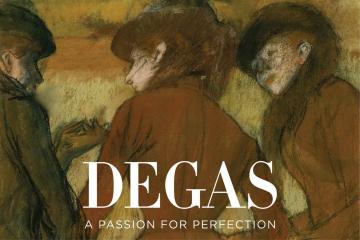 The Denver Art Museum provided the perfect setting for an April 2018 Commodore Classroom featuring Leonard Folgarait, Distinguished Professor of History of Art, and the current exhibit Degas: A Passion for Perfection. Folgarait joined the Denver Vanderbilt Chapter on April 15 to discuss the work of Edgar Degas and to tour the museum’s exhibit of more than 100 works by the artist from 1855-1906. Following his lecture, “Paris, Impressionism and Degas,” guests viewed the exhibit using newly acquired knowledge and appreciation of the artist and his works. Folgarait has frequently traveled to Paris to teach a Maymester class and knows the city like a native.
The Denver Art Museum provided the perfect setting for an April 2018 Commodore Classroom featuring Leonard Folgarait, Distinguished Professor of History of Art, and the current exhibit Degas: A Passion for Perfection. Folgarait joined the Denver Vanderbilt Chapter on April 15 to discuss the work of Edgar Degas and to tour the museum’s exhibit of more than 100 works by the artist from 1855-1906. Following his lecture, “Paris, Impressionism and Degas,” guests viewed the exhibit using newly acquired knowledge and appreciation of the artist and his works. Folgarait has frequently traveled to Paris to teach a Maymester class and knows the city like a native.
Degas’s paintings, drawings, pastels, etchings, monotypes, and sculptures in bronze are on view at the Denver Art Museum, the sole American venue for the exhibition, through May 20. The exhibit focuses on the most prominent and recurring themes throughout Degas’s 60-year career, including his interest in learning from the art of the past and from that of his contemporaries, a lifelong fascination with the nude, a passion for horses, and his strong interest in opera and dance.
The works reflect the artist’s transformation from a portraitist and painter of historical subjects to one interested in the contemporary life of late-nineteenth-century Paris. By experimenting constantly throughout his career he developed techniques that allowed him to capture modern subject matter through sharp and precise lighting, such as café concerts, street scenes with new electric lighting, sporting events, and theatrical settings.
Posted by vrcvanderbilt on April 16, 2018 in Events, HART, Lectures, News, Student/Alumni, VRC
HART Students Matthew Shorten and Samantha Smith Present Papers at Undergraduate Writing Symposium
Our department proudly recognizes two students who presented papers from their History of Art classes in the annual Undergraduate Writing Symposium on March 25 at the John Siegenthaler Center on the Peabody campus. Sophomore Matthew Shorten and senior Samantha Smith participated in a panel entitled “Objects of Culture and History,” chaired by Betsey Robinson, associate professor of history of art.
 Shorten presented “Japanese Tea, Ceremony, and Ceramics: Agents of Healing, Transformation, and Dynamic Cultural Symbolism,” a paper he originally wrote in the course, Healing and Art in East Asia, taught by Tracy Miller, associate professor of history of art. In his paper he examined the connection between tea as a health beverage and aesthetic preoccupation in early modern Japan and the development of the nation’s collective culture.
Shorten presented “Japanese Tea, Ceremony, and Ceramics: Agents of Healing, Transformation, and Dynamic Cultural Symbolism,” a paper he originally wrote in the course, Healing and Art in East Asia, taught by Tracy Miller, associate professor of history of art. In his paper he examined the connection between tea as a health beverage and aesthetic preoccupation in early modern Japan and the development of the nation’s collective culture.
Smith presented “Romanticizing Ruin: The Imaginative Landscapes of Hubert Robert,” a paper assessing the career of the eighteenth-century artist Hubert Robert, demonstrating how he built upon the tradition of capriccio artists Giovanni 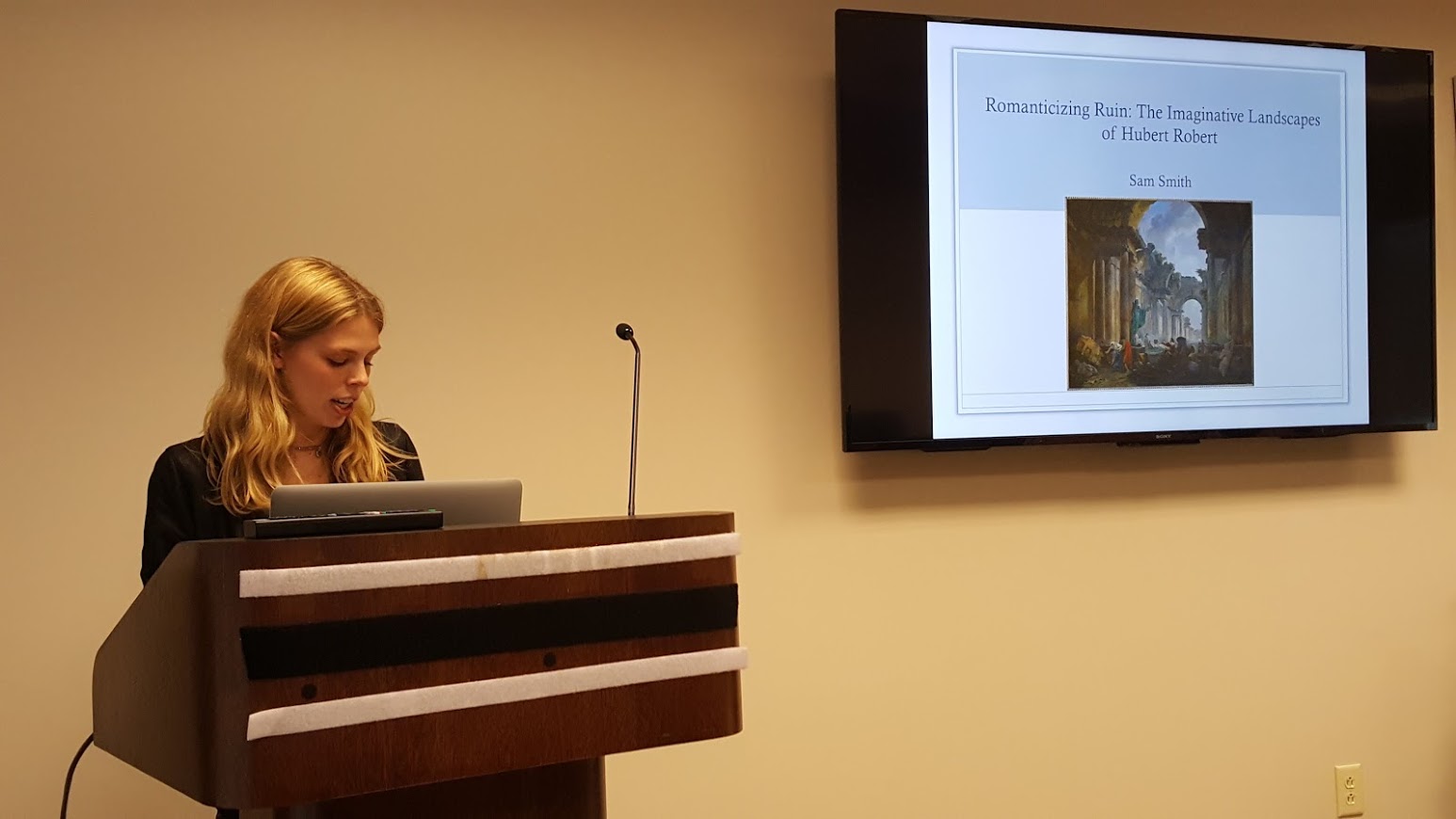 Paolo Panini and Giovanni Battista Piranesi to create powerful works in response to the urbanization of Paris, and then the French Revolution. Smith became fascinated with the work of Robert while studying him at Saint Andrew’s University in Scotland, and followed up with a paper in Robinson’s seminar, Ancient Landscapes.
Paolo Panini and Giovanni Battista Piranesi to create powerful works in response to the urbanization of Paris, and then the French Revolution. Smith became fascinated with the work of Robert while studying him at Saint Andrew’s University in Scotland, and followed up with a paper in Robinson’s seminar, Ancient Landscapes.
In its tenth year as a major undergraduate research event, the Undergraduate Writing Symposium is a forum for excellent undergraduate writing of all kinds. In addition to essays, the symposium features the great diversity of research and writing projects produced by students in all four undergraduate schools, and competition is intense for participation in the ten panels. Congratulations to our two HART students for their scholarly contributions!
Posted by vrcvanderbilt on April 16, 2018 in Events, HART, Lectures, News, Student/Alumni, Vanderbilt University, VRC
Rebecca VanDiver Examines Collages of Loïs Mailou Jones in “American Art” Cover Story
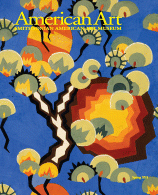 Loïs Mailou Jones (1905–1998) began traveling to Haiti in the summer of 1954. In the 1960s the artist produced a series of collages that signaled, via text and symbols, her experiences with and protracted study of Haitian Vodou ceremonial practices.
Loïs Mailou Jones (1905–1998) began traveling to Haiti in the summer of 1954. In the 1960s the artist produced a series of collages that signaled, via text and symbols, her experiences with and protracted study of Haitian Vodou ceremonial practices.
Rebecca VanDiver’s cover article, “The Diasporic Connotations of Collage: Loïs Mailou Jones in Haiti, 1954–1964,” featured in American Art (Spring 2018), examines the artist’s aesthetic transformation over the next decade—the move from her representational paintings of the 1950s to her abstract collages of the 1960s. VanDiver, assistant professor of African American art, argues that Jones’s eventual turn to collage is connected to her acquisition of a diasporic literacy and her ongoing study of Vodou symbolism, particularly the emblematic drawings known as vèvè.
After discussing prior African American artistic engagements with Haiti, trends in modern Haitian art, Jones’s role as cultural ambassador, and the specifics of the multilayered Haitian Vodou rituals, VanDiver turns her attention to the ways in which collage offered the artist an opportunity to experiment with and make sense of an unfamiliar cultural practice.
“Finally, this focused analysis of Jones’s collages suggests this medium/technique is especially appropriate to diasporic expression because it is predicated on the cut and the subsequent combination of disparate elements,” wrote VanDiver, who is completing a book-length manuscript on Loïs Mailou Jones.
Her research, centered on twentieth-century black women artists, African American artistic engagements with Africa, and the politics of exhibition and display, has appeared in Archives of American Art Journal, Space and Culture, and Transition.
*Cover of American Art 32, no. 1 (Spring 2018): Loïs Mailou Jones, Textile Design for Cretonne, 1928. Watercolor on paper, 28 × 21 in. Smithsonian American Art Museum, Washington, D.C., Bequest of the artist, 2006.24.10. Courtesy Loïs Mailou Jones Pierre-Noël Trust
Posted by vrcvanderbilt on April 10, 2018 in HART, News, Vanderbilt University, VRC
Tracy Miller Presents Paper on Generative Design in Architecture of Medieval Chinese Buddhism
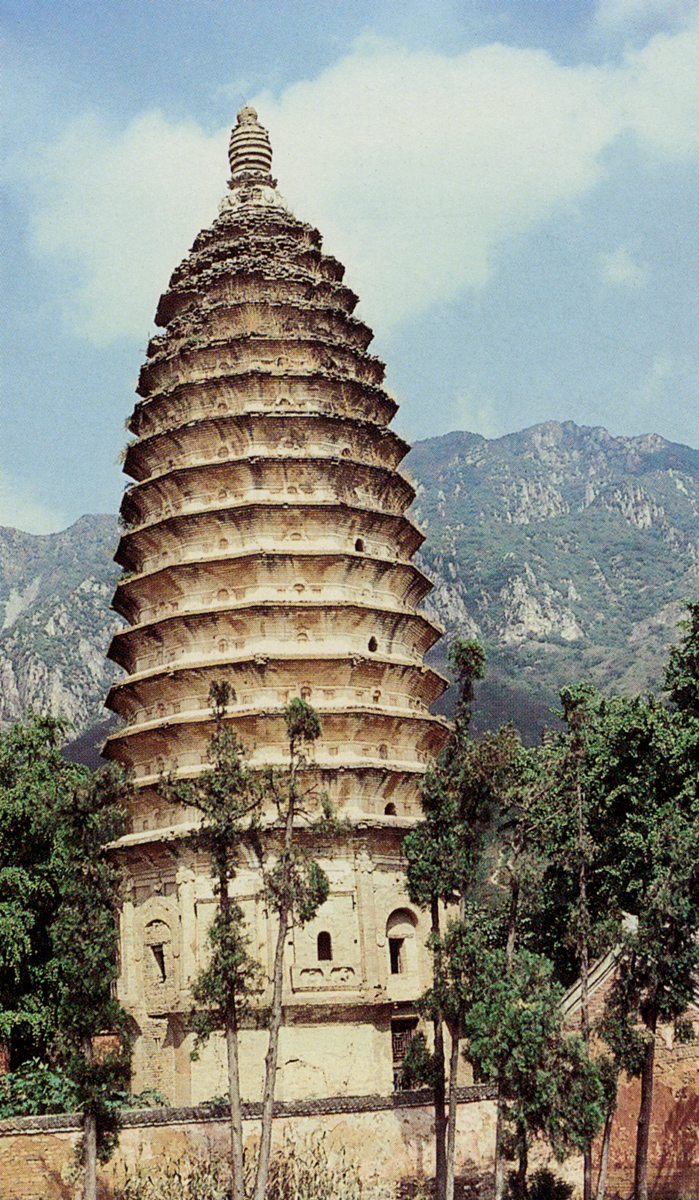 Tracy Miller, associate professor of history of art, will present a paper, “Rethinking Creativity: Generative Design in the Architecture of Medieval Chinese Buddhism,” on April 19 at an event hosted by the Department of History of Art and Architecture, Harvard University, and moderated by Eugene Wang, Abby Aldrich Rockefeller Professor of Asian Art.
Tracy Miller, associate professor of history of art, will present a paper, “Rethinking Creativity: Generative Design in the Architecture of Medieval Chinese Buddhism,” on April 19 at an event hosted by the Department of History of Art and Architecture, Harvard University, and moderated by Eugene Wang, Abby Aldrich Rockefeller Professor of Asian Art.
The famous pagoda at Songyuesi (ca. 523 CE), located on Mount Song, near the former Northern Wei capital at Luoyang, is not only the earliest full-size pagoda extant in China, but also the only one with a dodecagonal plan. Miller will explore how a particular design strategy, traces of which can be found in divinatory devices, reliquaries, and the plans of towering Indic temples, may have been used to create the plan of the Songyuesi pagoda in an effort to imbue the structure with an inherent generative power.
“The technique may have been seen as a type of geometric ‘proof’ of the Buddhist cosmological system, providing evidence that ritual objects could be designed by humans to transmit natural, life-giving energy to those who used them,” wrote Miller, who is currently writing a monograph on the use of Indic design strategies in the Buddhist temple architecture of Early Medieval and Medieval China.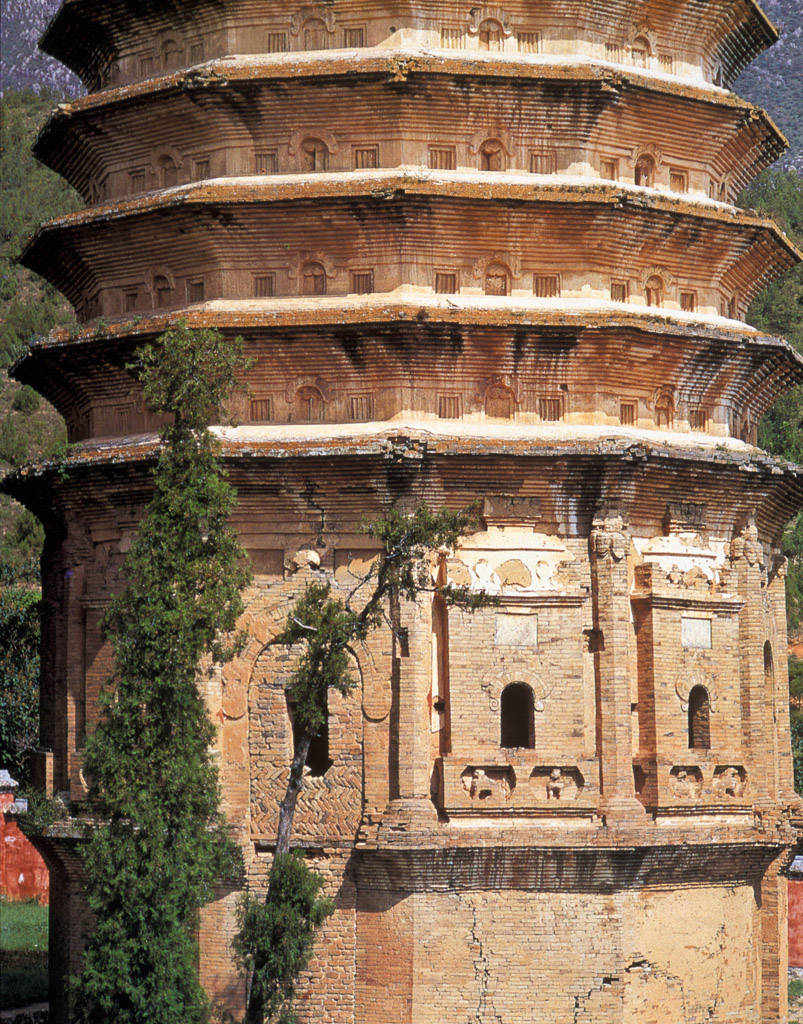
Miller’s research focuses on the impact of belief in divinity on the production of art, architecture, and spaces for spiritual encounters. Her publications include The Divine Nature of Power: Chinese Ritual Architecture at the Sacred Site of Jinci (Harvard University Asia Center, 2007), as well as articles and book chapters on ritual complexes associated with Buddhism, Daoism, and Confucianism.
*Pagoda at Songyuesi (ca. 523 CE), on Mount Song, near Luoyang; and detail
Posted by vrcvanderbilt on April 9, 2018 in Events, HART, Lectures, News, VRC

©2026 Vanderbilt University ·
Site Development: University Web Communications